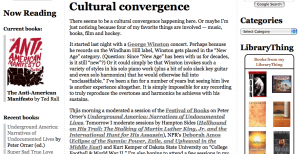I’m doing six interviews in two days about the Manifesto. Most of these are streamable online. Make sure to note timezones!
Thursday, September 30th
Radio Interview No. 1
WSBA Morning Show, York PA
8:10-8:51am Eastern time
Radio Interview No. 2
KPFA Uprising Radio, Los Angeles
8:40-8:55am Pacific time
Radio Interview No. 3
WRIF, Detroit
Peter Werbe “Night Call”
1pm Eastern time
Friday, October 1st
Radio Interview No. 1
KPFT, Houston (Pacifica)
12:00-12:30 Central time
Radio Interview No. 2
“News Dissector” Radio Show with Danny Schecter
1:30-1:50 pm Eastern time
Radio Interview No. 3
WEOS
Tish Pearlman Out of Bounds
2:00-2:30 Eastern time

